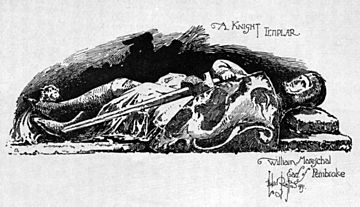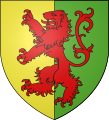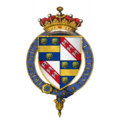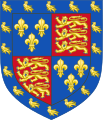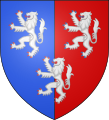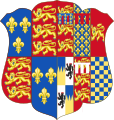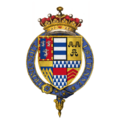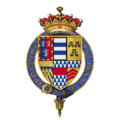Earl of Pembroke facts for kids
Quick facts for kids Earldom of Pembrokeheld with Earldom of Montgomery |
|
|---|---|
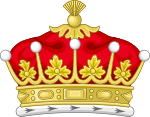 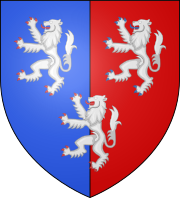
Arms of Herbert: Per pale azure and gules, three lions rampant argent
|
|
| Creation date | 1138 (first creation) 1199 (second creation) 1247 (third creation) 1339 (fourth creation) 1414 (fifth creation) 1447 (sixth creation) 1452 (seventh creation) 1468 (eighth creation) 1479 (ninth creation) 1551 (tenth creation) |
| Monarch | Stephen of England |
| Peerage | Peerage of England |
| First holder | Gilbert de Clare, 1st Earl of Pembroke |
| Present holder | William Herbert, 18th Earl of Pembroke (10th creation) |
| Heir apparent | Reginald Henry Michael Herbert, Lord Herbert |
| Remainder to | the male heirs of the body lawfully begotten |
| Subsidiary titles | Earl of Montgomery Baron Herbert of Cardiff Baron Herbert of Shurland Baron Herbert of Lea (1861) |
| Seat(s) | Wilton House |
| Former seat(s) | Pembroke Castle |
| Motto | Ung je serviray ("One will I serve") |
The Earl of Pembroke is a special title in England. It was first given out in the 1100s by King Stephen of England. This title is linked to Pembroke, Pembrokeshire in West Wales. It has been created ten different times over history. Because the title was given out so many times, the original home, Pembroke Castle, is no longer connected to it.
As of 2018[update], the current Earl is William Herbert, 18th Earl of Pembroke. This is the 10th time the title has been created. For the last 400 years, his family's main home has been Wilton House in Wiltshire.
The Earls of Pembroke also hold the title Earl of Montgomery. This title was created for Philip Herbert. He was the younger son of Henry Herbert, 2nd Earl of Pembroke. He became the 4th Earl of Pembroke in 1630.
The current Earls of Pembroke also have other titles. These include Baron Herbert of Cardiff (from 1551) and Baron Herbert of Shurland (from 1605). They also hold Baron Herbert of Lea (from 1861). Most of these titles are part of the Peerage of England. However, the Barony of Herbert of Lea is part of the Peerage of the United Kingdom.
On September 1, 1532, King Henry VIII created a new title. He made his future queen, Anne Boleyn, the Marquess of Pembroke. This was to honor his great-uncle, Jasper Tudor. Jasper Tudor had been an Earl of Pembroke in the 1400s. It also honored Henry VIII's father, Henry VII. Henry VII was born at Pembroke Castle in 1457.
Contents
- History of the Earls of Pembroke
- First Earls: The de Clare Family (1138)
- Second Earls: The Marshal Family (1199)
- Third Earls: The de Valence Family (1247)
- Fourth Earls: The Hastings Family (1339)
- Fifth Earls: The Plantagenet Family (1414)
- Sixth Earls: The de la Pole Family (1447)
- Seventh Earls: The Tudor Family (1452)
- Eighth Earls: The Herbert Family (1468)
- Ninth Earls: The House of York (1479)
- Marquess of Pembroke: Anne Boleyn (1532)
- Tenth Earls: The Herbert Family (1551)
- Family Tree of the Earls of Pembroke (Eighth and Tenth Creations)
- Places Named After the Earls of Pembroke
- Images for kids
- Sources
- See also
History of the Earls of Pembroke
The title of Earl of Pembroke has been held by many English families. It was originally connected to the area of Pembrokeshire.
First Earls: The de Clare Family (1138)
The first time the title was created was in 1138. King Stephen gave the Earldom of Pembroke to Gilbert de Clare, 1st Earl of Pembroke. Gilbert de Clare (who died in 1148) was the son of Gilbert Fitz-Richard. His family owned the area of Strigul, which is now Chepstow.
In the Battle of Lincoln (1141), Gilbert de Clare fought for King Stephen. After the king lost, Gilbert joined the side of Empress Matilda. Later, he made up with Stephen when the king got his throne back. Gilbert married Isabel, who was the daughter of Robert de Beaumont, Earl of Leicester.
It is believed that Arnulf de Montgomery was made Earl of Pembroke even earlier. This was likely done by William Rufus. Arnulf was given the land of Pembroke by the king. This happened after his family built Pembroke Castle in the late 1000s.
- Gilbert de Clare, 1st Earl of Pembroke (1100–1147)
- Richard de Clare, 2nd Earl of Pembroke (1130–1176)
- Gilbert de Clare, 3rd Earl of Pembroke (1173–1185)
- Isabel de Clare, 4th Countess of Pembroke (1172–1220)
Richard de Clare, also known as Strongbow, supported King Stephen. King Henry II of England did not like Strongbow. So, when Strongbow's father died in 1148, the king did not let Richard become Earl of Pembroke.
Richard had many debts. In 1168, he got a chance to improve his situation. He was chosen to lead an army to Ireland. This army was to help Diarmait Mac Murchada, the former King of Leinster. Strongbow went to Ireland in 1170. He captured Waterford and Dublin. He married Diarmuid's daughter, Aoife MacMurrough. After Diarmuid died in 1171, Strongbow claimed to be King of Leinster.
King Henry II was worried about Strongbow's power. In 1171, he took away Strongbow's new lands. Henry II then invaded Ireland himself. Strongbow helped King Henry II in 1173. This was during a fight against the king's rebellious sons. Strongbow died in 1176.
Strongbow had a son named Gilbert. But Gilbert was too young to officially become Earl of Pembroke. His father, Strongbow, had not even held the title himself. When Gilbert died in 1185, his sister Isabel de Clare became Countess of Pembroke. She held the title on her own until she died in 1220.
Later, the title of Earl was created again for Isabel's husband. This was the famous Sir William Marshal.
Second Earls: The Marshal Family (1199)
In 1189, William Marshal was 43 years old. Many people thought he was the greatest knight in Christendom. He married Isabel de Clare. In 1199, King John of England made him the 1st Earl of Pembroke.
William Marshal had served King Henry II and King Richard I of England. He was loyal to King Richard and King John. He defended King John against French and English rebels. He was there when the Magna Carta was signed in 1215.
When King John died in 1216, William Marshal was 70 years old. He was chosen to be the Regent for the young King Henry III of England. This meant he ruled the kingdom until the king was old enough. He defeated the rebels and their French allies. He also reissued the Magna Carta to help bring peace.
William Marshal became ill in early 1219. He died on May 14. His five sons became Earls of Pembroke one after another.
- William Marshal, 1st Earl of Pembroke (1146–1219)
- William Marshal, 2nd Earl of Pembroke (1190–1231)
- Richard Marshal, 3rd Earl of Pembroke (c. 1191–1234)
- Gilbert Marshal, 4th Earl of Pembroke (died 1241)
- Walter Marshal, 5th Earl of Pembroke (c. 1199–1245)
- Anselm Marshal, 6th Earl of Pembroke (died 1245)
William Marshal's oldest son, William Marshal (died 1231), was the 2nd Earl. He spent years fighting in Wales and Ireland. He also served King Henry III in France. He had no children.
His brother Richard Marshal (died 1234) became the 3rd Earl. He became a leader of the nobles who were unhappy with King Henry III. Richard was afraid of being betrayed. He refused to visit the King in 1233. King Henry then called him a traitor. Richard went to Ireland. There, his enemies attacked him. In April 1234, he was defeated, wounded, and died as a prisoner.
His brother Gilbert (died 1241) became the 4th Earl. He was a friend of Richard, 1st Earl of Cornwall. When another brother, Anselm, the 6th Earl, died in 1245, there were no more male heirs in the Marshal family. The family's large lands were divided among Anselm's five sisters. The Earldom of Pembroke went back to the Crown.
Third Earls: The de Valence Family (1247)
- William de Valence, 1st Earl of Pembroke (c. 1225–1296)
- Aymer de Valence, 2nd Earl of Pembroke (c. 1275–1324) (title ended)
The next person to hold the lands of Pembroke was William de Valence. He was a younger son of Hugh X of Lusignan. His mother, Isabella of Angoulême, was the widow of King John of England. In 1247, William moved from France to England. His half-brother, Henry III, was king.
The King arranged for William to marry Joan de Munchensi. She was a granddaughter of the great William Marshal, 1st Earl of Pembroke. William de Valence was given control of the lands and the title of Earl of Pembroke. This made him very rich and powerful. Because of this, he was not very popular.
He was involved in the Second Barons' War. He supported the King and Prince Edward against the rebels. The rebels were led by Simon de Montfort, 6th Earl of Leicester. After the rebels were defeated in 1265, William continued to serve King Henry III and then King Edward I. He died in 1296.
William's oldest son who was still alive, Aymer (c. 1275–1324), inherited his father's lands. He was officially recognized as Earl of Pembroke after his mother died in 1307. He was put in charge of Scotland in 1306. But when Edward II became king, Aymer's power decreased. This was because Piers Gaveston became very powerful.
Aymer became a leader among the unhappy nobles. But in 1312, he left the allied lords. This happened after the Earl of Warwick executed Gaveston. Aymer then joined the King. He was at the Battle of Bannockburn in 1314. He later helped King Edward defeat Thomas, 2nd Earl of Lancaster. Aymer died in 1324. His wife, Marie de St Pol, founded Pembroke College, Cambridge.
Fourth Earls: The Hastings Family (1339)
- Laurence Hastings, 1st Earl of Pembroke (1319–1348)
- John Hastings, 2nd Earl of Pembroke (1347–1375)
- John Hastings, 3rd Earl of Pembroke (1372–1389) (title ended)
Lawrence Hastings was a great-grandson of William de Valence. He was recognized as Earl of Pembroke. He had inherited some of the lands from the Valence Earls. His son John (died 1376) married Margaret, King Edward III's daughter. When John's grandson died in 1389 without children, the Earldom of Pembroke went back to the Crown.
Fifth Earls: The Plantagenet Family (1414)
- Humphrey of Lancaster, 1st Duke of Gloucester (1390–1447) (title ended)
Humphrey was the fourth son of King Henry IV. He was made Duke of Gloucester and Earl of Pembroke for life. These titles later became hereditary. If Humphrey had no heirs, the Earldom of Pembroke would go to William de la Pole, 1st Duke of Suffolk.
Sixth Earls: The de la Pole Family (1447)
- William de la Pole, 1st Duke of Suffolk (1396–1450) (title ended)
When Humphrey died in 1447 without children, William de la Pole became Earl of Pembroke. He was executed in 1450. His titles were taken away.
Seventh Earls: The Tudor Family (1452)
- Jasper Tudor, 1st Duke of Bedford (c. 1431–1495) (title lost 1461; restored 1485) (title ended)
Sir Jasper Tudor was the half-brother of King Henry VI. He supported the Lancastrian side in the Wars of the Roses. His title was taken away for 24 years when the House of York was in power.
Eighth Earls: The Herbert Family (1468)
- William Herbert, 1st Earl of Pembroke (1423–1469)
- William Herbert, 2nd Earl of Pembroke (died 1491) (title given up 1479)
After Jasper Tudor lost his title, Sir William Herbert was made Baron Herbert by Edward IV. William Herbert was a strong supporter of the Yorkist side. He captured Jasper Tudor during the civil war. For this, he was made Earl of Pembroke in 1468.
The second Earl gave up his title to Edward IV ten years later. In return, he received the Earldom of Huntingdon.
The grandson of William Herbert, the 1st Earl, was later made Earl of Pembroke in 1551. The current Earl is a descendant of this family.
Ninth Earls: The House of York (1479)
- Edward Plantagenet (1470–1483) (title joined with the Crown 1483)
In 1479, Edward IV gave the title to his son, Edward, Prince of Wales. When this prince became King Edward V of England, the Earldom of Pembroke became part of the Crown. After the House of York was defeated, the title went back to the Tudors when Henry VII became king.
Marquess of Pembroke: Anne Boleyn (1532)
- Anne Boleyn, (1501/7–1536)
On September 1, 1532, Anne Boleyn was given the Marquessate of Pembroke. This was a few months before she married Henry VIII. She was later found guilty of treason and executed in May 1536. At that point, the title ended because she had no sons.
Tenth Earls: The Herbert Family (1551)
The title was next given to Sir William Herbert. His father, Richard, was a son of the 1st Earl of Pembroke from the Herbert family. William Herbert married Anne Parr, who was the sister of Henry VIII's sixth wife. He was made Earl in 1551. The title has been held by his descendants ever since.
- William Herbert, 1st Earl of Pembroke (1501–1570)
- Henry Herbert, 2nd Earl of Pembroke (1534–1601)
- William Herbert, 3rd Earl of Pembroke (1580–1630)
- Philip Herbert, 4th Earl of Pembroke, 1st Earl of Montgomery (1584–1649)
- Philip Herbert, 5th Earl of Pembroke, 2nd Earl of Montgomery (1621–1669)
- William Herbert, 6th Earl of Pembroke, 3rd Earl of Montgomery (1642–1674)
- Philip Herbert, 7th Earl of Pembroke, 4th Earl of Montgomery (c. 1652–1683)
- Thomas Herbert, 8th Earl of Pembroke, 5th Earl of Montgomery (1656–1733)
- Henry Herbert, 9th Earl of Pembroke, 6th Earl of Montgomery (1693–1750)
- Henry Herbert, 10th Earl of Pembroke, 7th Earl of Montgomery (1734–1794)
- George Augustus Herbert, 11th Earl of Pembroke, 8th Earl of Montgomery (1759–1827)
- Robert Henry Herbert, 12th Earl of Pembroke, 9th Earl of Montgomery (1791–1862)
- George Robert Charles Herbert, 13th Earl of Pembroke, 10th Earl of Montgomery (1850–1895)
- Sidney Herbert, 14th Earl of Pembroke, 11th Earl of Montgomery (1853–1913)
- Reginald Herbert, 15th Earl of Pembroke, 12th Earl of Montgomery (1880–1960)
- Sidney Charles Herbert, 16th Earl of Pembroke, 13th Earl of Montgomery (1906–1969)
- Henry George Charles Alexander Herbert, 17th Earl of Pembroke, 14th Earl of Montgomery (1939–2003)
- William Alexander Sidney Herbert, 18th Earl of Pembroke, 15th Earl of Montgomery (b. 1978)
The heir apparent is the current Earl's son, Reginald Henry Michael Herbert, Lord Herbert (born 2012).
William Herbert, the 1st Earl, was very important during the reign of Edward VI. He was an executor of Henry VIII's will. He received valuable land grants. He supported John Dudley. After Dudley's rival, Somerset, fell from power, Herbert gained some of his lands and a noble title.
He was one of the advisors for Lady Jane Grey. But he quickly supported Mary when Lady Jane's cause failed. Mary sometimes doubted his loyalty. However, he served as governor of Calais and president of Wales. He also had some trust from Philip II of Spain.
The Earl kept his position under Elizabeth until 1569. He was suspected of supporting a marriage between Mary, Queen of Scots, and the Duke of Norfolk. Among the lands given to Herbert was Wilton House, near Salisbury. This is still the home of the Earls of Pembroke today.
His older son Henry (c. 1534–1601) became the 2nd Earl. He was president of Wales from 1586 until his death. In 1577, he married Mary Sidney. She was a famous Countess of Pembroke (c. 1561–1621). She was the sister of Sir Philip Sidney.
Sir Philip spent the summer of 1580 with her at Wilton House. Here, he started writing Countess of Pembroke's Arcadia for her. They also worked on a version of the Psalms. After her brother died, she helped publish his writings. She also supported other poets. Spenser dedicated his Ruines of Time to her. In 1599, Queen Elizabeth visited her at Wilton. The Countess wrote a play for the occasion. She later lived mostly in London.
Some scholars think Mary Sidney might have written the plays of William Shakespeare. Robin Williams' book Sweet Swan of Avon talks about her life and her sons.
William Herbert, 3rd Earl of Pembroke (1580–1630) was the eldest son of the 2nd Earl and Mary Sidney. He was an important person in society and at the court of James I. He often disagreed with the plans of the Duke of Buckingham. He was also very interested in the colonization of America.
He was Lord Chamberlain of the royal household from 1615 to 1625. He was Lord Steward from 1626 to 1630. In 1624, he was Chancellor of the University of Oxford. Thomas Tesdale and Richard Wightwick renamed Broadgates Hall to Pembroke College in his honor.
William Herbert died in London on April 10, 1630. He had no sons. He enjoyed literature and wrote poems. He was a close friend of the poet John Donne. He was also generous to writers like Ben Jonson and Massinger.
His brother, Philip Herbert, 4th Earl of Pembroke (1584–1650), was a favorite of James I for some years. This was because he was handsome and loved hunting. In 1605, King James I of England made him Earl of Montgomery and Baron Herbert of Shurland. Since 1630, the head of the Herbert family has held both titles: Earl of Pembroke and Montgomery.
Philip often got into arguments. But he kept the respect of James I. The king gave him many lands and jobs. King Charles I also trusted him. Charles made him Lord Chamberlain in 1626 and often visited him at Wilton.
Philip tried to make peace between the King and the Scots in 1639 and 1640. But when the King and the English parliament argued again in 1640, Philip left the King's side. The King soon took away his job as chamberlain. Philip was trusted by the parliament. He was made governor of the Isle of Wight. He represented parliament in talks several times.
From 1641 to 1643, and again from 1647 to 1650, he was Chancellor of the University of Oxford. In 1649, even though he was a noble, he was elected to the House of Commons. He became a member for Berkshire. The Earl collected many pictures and had some interest in architecture.
His oldest son who was still alive, Philip (1621–1669), became the 5th Earl of Pembroke and 2nd Earl of Montgomery. He was married twice. Three of his sons became Earls after him. Thomas, the 8th Earl (c. 1656–1733), was important during the reigns of William III and Anne.
From 1690 to 1692, Thomas was first Lord of the Admiralty. Then he was Lord Privy Seal until 1699. In 1697, he was Great Britain's main representative at the congress of Ryswick. He was also Lord High Admiral for a short time. He was Lord President of the Council and Lord Lieutenant of Ireland. He was President of the Royal Society from 1689–1690.
His son Henry, the 9th Earl (c. 1693–1750), was a soldier. But he was better known as the "architect Earl." He helped build Westminster Bridge. The title then went to Henry, the 10th Earl (1734–1794), who was a soldier. He wrote a book called "The Method of Breaking Horses" (1762). Then it went to George Augustus, the 11th Earl (1759–1827), who was an ambassador.
Robert Henry, the 12th Earl (1791–1862), died in France without children. George Robert Charles, the 13th Earl (1850–1895), was a grandson of the 10th Earl. His younger brother Sidney (born 1853) became the 14th Earl. Sidney had been a Member of Parliament.
His eldest son Reginald became the 15th Earl in 1913. His eldest son Sidney, the 16th Earl, worked for the Duke of Kent. He also served as a trustee of the National Gallery. His son Henry Herbert, 17th Earl of Pembroke, became the 17th Earl in 1969. He had a notable career as a filmmaker.
As of 2018[update], the current Earl is William Herbert, 18th Earl of Pembroke. He became Earl of Pembroke and 15th of Montgomery when his father died in 2003.
Family Tree of the Earls of Pembroke (Eighth and Tenth Creations)
| William HERBERT * c. 1423 † 1469 |
|||||||||||||||||||||||
|
|
|
|
|
|
|
||||||||||||||||||
|
|
|
|
|
|
|||||||||||||||||||
| William * 1451 † 1491 |
Richard *… †1510 |
||||||||||||||||||||||
|
|
|
||||||||||||||||||||||
| William * 1501 † 1570 |
|||||||||||||||||||||||
|
|
|
||||||||||||||||||||||
| Henry * a.1538 † 1601 |
|||||||||||||||||||||||
|
|
|
|
|
|
|
||||||||||||||||||
|
|
|
|
|
|
|||||||||||||||||||
| William *1580 †1630 |
Philip *1584 †1649 |
||||||||||||||||||||||
|
|
|
||||||||||||||||||||||
| Philip *1621 †1669 |
|||||||||||||||||||||||
|
|
|
|
|
|
|
|
|
|
|||||||||||||||
|
|
|
|
|
|
|
|
|
|
|||||||||||||||
| William *1642 †1674 |
Philip *c. 1652 †1683 |
Thomas *1656 †1733 |
|||||||||||||||||||||
|
|
|
|
|
|
|
||||||||||||||||||
|
|
|
|
|
||||||||||||||||||||
| Henry *1693 †1750 |
William *b.1696 †1757 |
||||||||||||||||||||||
|
|
|
|
|
||||||||||||||||||||
| Henry *1734 †1794 |
Earls of Carnarvon | ||||||||||||||||||||||
|
|
|
||||||||||||||||||||||
| Henry *1759 †1827 |
|||||||||||||||||||||||
|
|
|
|
|
|
|
||||||||||||||||||
|
|
|
|
|
|
|||||||||||||||||||
| Robert *1791 †1862 |
Sidney *1810 †1861 |
||||||||||||||||||||||
|
|
|
|
|
|
|
||||||||||||||||||
|
|
|
|
|
|
|||||||||||||||||||
| George *1850 †1895 |
Sidney *1853 †1913 |
||||||||||||||||||||||
|
|
|
||||||||||||||||||||||
| Reginald *1880 †1960 |
{{{ }}} | ||||||||||||||||||||||
|
|
|
||||||||||||||||||||||
| Sidney *1906 †1969 |
{{{ }}} | ||||||||||||||||||||||
|
|
|
||||||||||||||||||||||
| Henry *1939 †2003 |
{{{ }}} | ||||||||||||||||||||||
|
|
|
||||||||||||||||||||||
| William *1978 |
|||||||||||||||||||||||
|
|
|
||||||||||||||||||||||
| Reginald *2012 |
{{{ }}} | ||||||||||||||||||||||
Places Named After the Earls of Pembroke
Many places around the world are named after the Earls of Pembroke.
- Pembroke College, Cambridge, started in 1347, is named after its founder. She was Marie de St Pol, Countess of Pembroke. She was the wife of Aymer de Valence, 2nd Earl of Pembroke.
- Pembroke College, Oxford, is named after William Herbert, 3rd Earl of Pembroke. He was the Chancellor of the University of Oxford when the college was founded in 1624.
- Pembroke College in Brown University in Providence, Rhode Island, U.S., is named after Pembroke College, Cambridge. This is because Roger Williams, who founded Providence, went to Cambridge.
- The city of Pembroke Pines, Florida, is thought to be named after an Earl of Pembroke. This Earl was an early landowner in the area.
- Pembroke, New Hampshire, was named after the ninth Earl by Governor Benning Wentworth.
- Pembroke, Kentucky, is not named after an Earl of Pembroke. It is named after a character in a popular novel from 1803.
- Pembroke, Ontario, is named to honor Sidney Herbert, 1st Baron Herbert of Lea. He was the younger son of George Herbert, 11th Earl of Pembroke.
- Pembroke Parish, Bermuda, is named after William Herbert, 3rd Earl of Pembroke.
- Pembroke, Malta, was named after Robert Herbert, 12th Earl of Pembroke. His younger brother, Sidney Herbert, 1st Baron Herbert of Lea, approved the name in 1859.
Images for kids
Sources
- G. T. Clark, The Earls, Earldom and Castle of Pembroke (Tenby 1880)
- J. R. Planche, "The Earls of Strigul " in vol. x. of the Proceedings of the British Archaeological Association (1855)
- G. E. Cokayne, Complete Peerage, vol. vi. (London, 1895).
- Giraldus Cambrensis, Expugnatio hibernica
- The Song of Dermot, edited by G. H. Orpen (1892).
- The metrical French life, Histoire de Guillaume le Marchal (ed. P. Meyer, 3 vols., Paris, 1891–1901)
- The Minority of Henry III, by G. J. Turner (Trans. Royal Hist. Soc., new series, vol. xviii. pp. 245295)
- W. Stubbs, Constitutional History, chs. xii. and xiv. (Oxford, 1896–1897).
See also
 In Spanish: Condado de Pembroke para niños
In Spanish: Condado de Pembroke para niños


